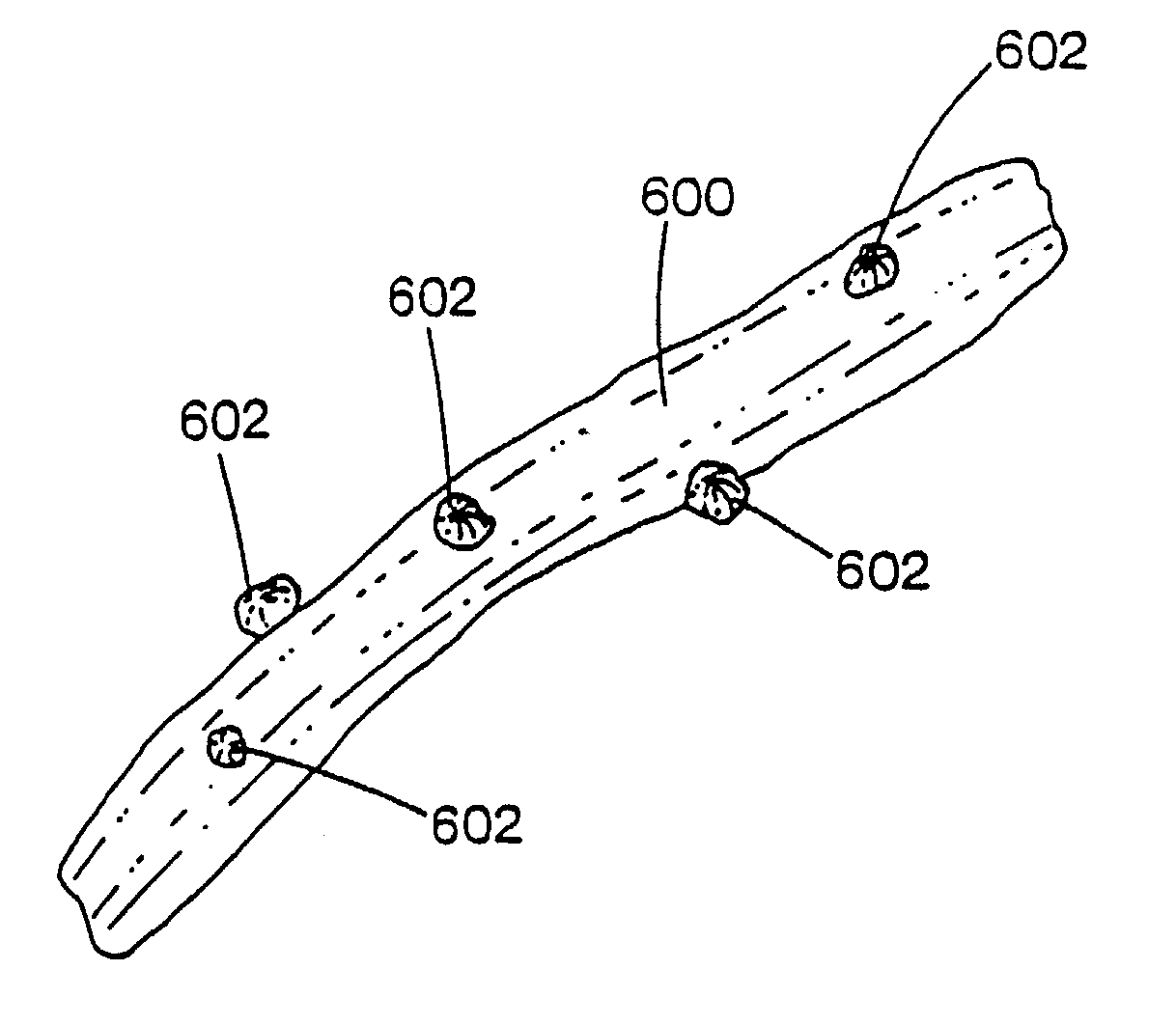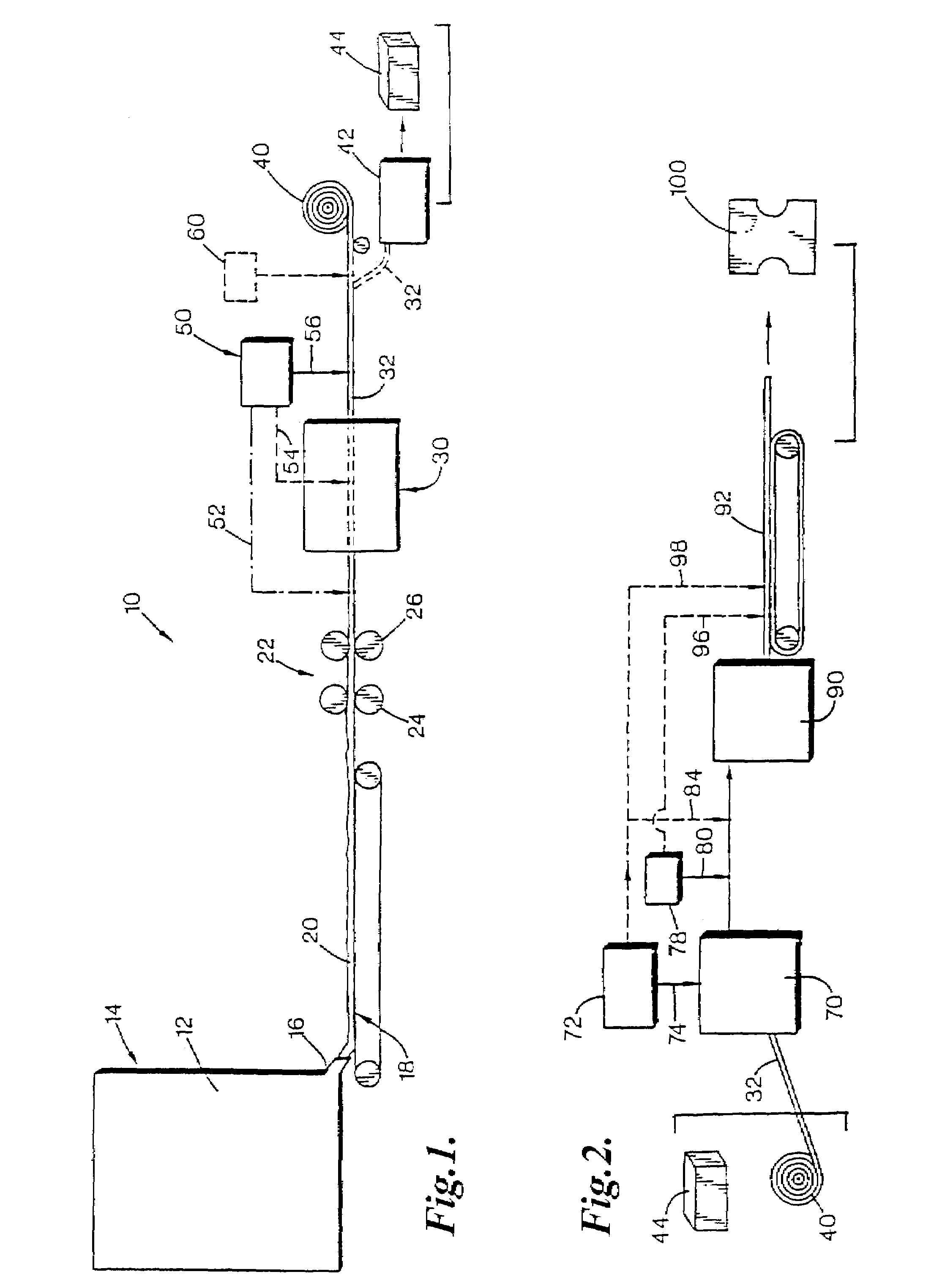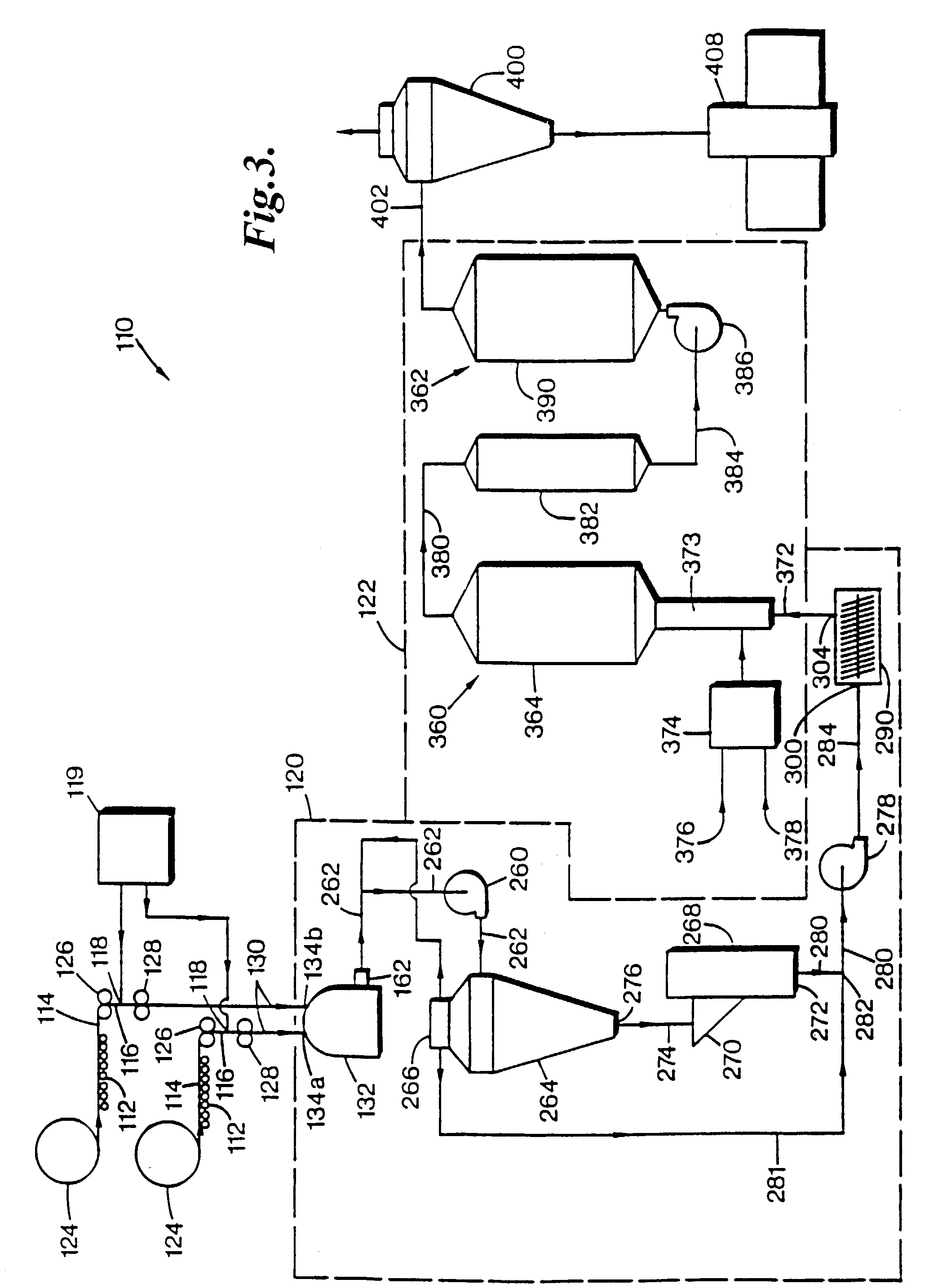[0013]Another
advantage of the present invention is that the binder containing particles can be applied to a
fiber product in a pattern that corresponds to a desired distribution of particles in fibrous material. The binder may then be reactivated to bind the particles in place. A reactivation fluid, such as a reactivation liquid, for example, can be applied to binder containing particles deposited in the areas of a diaper that will be initially moistened by
urine during use. Examples, without limitation, of suitable reactivation liquids include water, glycerin, lower
alkyl alcohols, polyols, such as glycols, glycerin and monoglycerates,
acetone, and combinations thereof, such as water and glycerin. When the reactivating fluid is a liquid, for example water, the liquid may be sprayed or otherwise applied and may be provided in the form of a gas. When water is the reactivating liquid, then it may be provided as steam or
moisture-laden gas, such as humid air. Other liquid reactivation fluids may be applied in the same manner. Binder containing particles, such as superabsorbent particles can be added to areas of the diaper to which an activation fluid is or will be applied and will be adhered almost exclusively in those areas where initial
urine absorption is required. Targeted activation of binder containing particles allows the particles to be efficiently and economically attached to the fibers, with reduced particle wastage. Moreover, targeted binder activation and particle adherence increases the absorptive efficiency of the product by diminishing excessive wicking of liquid within the plane of an absorptive product.
[0014]The particles of the present invention may be bound to the fibers with a polymeric or non-polymeric binder. The binder comprises binder molecules wherein the binder molecules have at least one functional group capable of forming a
hydrogen bond or coordinate
covalent bond with the particles, and at least one functional group capable of forming a
hydrogen bond with fibrous material. The polymeric binder may be selected from the group consisting of polyglycols, especially
polyethylene glycol or poly (propyleneglycol), a polycarboxylic acid, a polycarboxylate, a poly(
lactone)
polyol, such as diols, a
polyamide, a
polyamine, a polysulfonic acid, a polysulfonate and combinations thereof. Specific examples of some of these binders, without limitation, are as follows: polyglycols include
polypropylene glycol (PPG) and
polyethylene glycol (PEG); poly(
lactone)polyols include poly(
caprolactone)
diol; polycarboxylic acids include
polyacrylic acid (PAA); polyamides include
polyacrylamide or polypeptides; polyamines include
polyethylenimine and polyvinylpyridine; polysulfonic acids or polysulfonates include poly(
sodium-4-styrenesulfonate) or poly(2-acrylamido-methyl-1-propanesulfonic acid); and copolymers thereof (for example a
polypropylene glycol /
polyethylene glycol
copolymer). The polymeric binder typically has repeating units. The repeating unit may be the backbone of a compound, such as with a polypeptide, wherein the repeating polyamides occur in the
peptide chain. The repeating unit may also refer to units other than backbones, for instance a repeating
acrylic acid unit. In such a case, the repeating units may be the same or different. The binder has a functional group capable of forming a hydrogen bond or a coordinate covalent bond with particles, and a functional group capable of forming a hydrogen bond with the fibers. At this time, the most preferred polymeric binder is
polyethylene glycol although another especially preferred polymeric binder is an
amide binder such as a polypeptide binder with polyglycine being a specifically preferred example.
[0015]The non-polymeric binder has a volatility less than water, a functional group that is capable of forming a hydrogen bond or coordinate covalent bond with the particles, and a functional group that is capable of forming a hydrogen bond with the
cellulose or other fibers. The non-polymeric binder is an organic binder, and preferably includes a functional group selected from the group consisting of a carboxyl (for example, carboxylic acids), a
carboxylate, a carbonyl (for example, aldehydes), a
sulfonic acid, a
sulfonate, a
phosphoric acid, a
phosphate, an
amide, an amine, a hydroxyl (such as an
alcohol) and combinations thereof (for example, an
amino acid or an hydroxy acid), wherein there are at least two functionalities on the molecule selected from this group, and the two functionalities are the same or different. Examples of such binders include polyols, polyamines (a non-polymeric organic binder with more than one amine group), polyamides (a non-polymeric organic binder with more than one
amide group), polycarboxylic acids (a non-polymeric organic binder with more than one
carboxylic acid functionality), polyaldehydes (a non-polymeric organic binder with more than one
aldehyde), amino alcohols, hydroxy acids and other binders. These binders have functional groups that are capable of forming the specified bonds with the particles and fibers.
[0016]More preferably, the organic non-polymeric binder is selected from the group consisting of glycerin, a
glyceride monoester, including monoglycerides, a glycerin diester, including diglycerides,
glyoxal,
ascorbic acid,
urea,
glycine,
pentaerythritol, a
monosaccharide or a
disaccharide,
citric acid,
tartaric acid,
taurine (2-aminoethanesulfonic acid), p-
aminosalicylic acid,
dipropylene glycol,
urea derivatives such as DMDHEU, and combinations thereof. Suitable saccharides include glucose,
sucrose,
lactose,
ribose,
fructose,
mannose,
arabinose, and
erythrose. The preferred binders are non-polymeric molecules with a plurality of hydrogen bonding functionalities that permit the binder to form hydrogen bonds to both the fibers and particles. Particularly preferred binders include those that can form five or six membered rings, most preferably six membered rings, with a functional group on the particle surface. At present, glycerin, a glycerin monoester, a glycerin diester, and blends of these with
urea ate the preferred binders. At this time, a specifically preferred non-polymeric binder is glycerin.
[0017]The fibrous material may be cellulosic or synthetic fibers that are capable of forming hydrogen bonds with the binder, while the particles are selected to be of the type that are capable of forming hydrogen bonds or coordinate covalent bonds with the binder. It has unexpectedly been found that this binder
system secures particles to fibers exceptionally well. A superior fibrous product is therefore produced that has improved absorbent properties as compared to unbound or covalently bound particles. Formation of the noncovalent bond allows production of a
fiber product that is easily manufactured and a web that is easily densified, and that is readily biodegradable and disposable.
[0018]In one preferred embodiment, an absorbent product comprises a fibrous cellulosic mat that contains superabsorbent hydrogel particles in particulate form. The superabsorbent particles are capable of forming hydrogen bonds or coordinate covalent bonds with the binder, depending upon the binder, while the binder in turn is capable of forming hydrogen bonds with the hydroxyl groups of the
cellulose fibers. These noncovalent, relatively flexible bonds between the binder and particles maintain the particles in contact with the fibers, and
resist dislodgement of the particles by mechanical forces applied to the mat during manufacture, storage or use. The amount of binder present typically depends on a number of factors, including the nature of the binder and particles, and whether the particles are immediately added to the fibers or after a period of time. Hence, one skilled in the art will realize that the amount of binder suitable and particularly useful for a particular application will vary. However, the binder may suitably be present in an amount of from about 0.01 to 50 percent of the total weight of the particles, preferably from 0.03 to 20 percent, more preferably 0.03 to 5 percent and most preferably 0.03 to 1 percent. This lower percentage range produces very strong bonds that would require a much higher quantity of binder if the binder were applied to the fibers instead of the particles. The particles bound by the binder of the present invention (via hydrogen / coordinate covalent bonds) may suitably be present in an amount of 0.05 to 80 percent of the total weight of the fibrous material and the particles, preferably 1 to 80 percent or 5 to 80 percent, or more than 5 percent by weight. A particularly suitable range of particles is 5 to 70 percent by weight of the fibrous material and particles. A preferred weight ratio of particle to binder is 90:1 to 500:1. An example of a suitable particle is a
superabsorbent polymer such as a
starch graft polyacrylate hydrogel fine or larger size particle such as a granule, which is capable of forming hydrogen bonds with the binder. The binder also is capable of forming hydrogen bonds with the hydroxyl groups of the
cellulose, thereby securely attaching the superabsorbent particles to the fibers.
 Login to View More
Login to View More 


